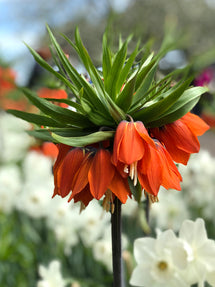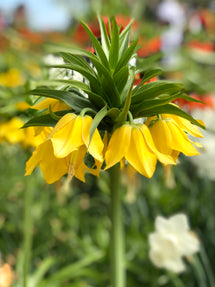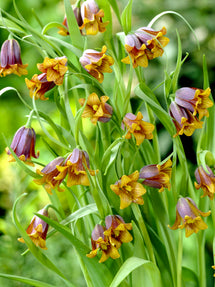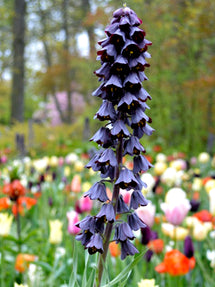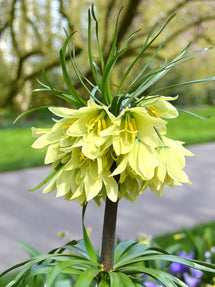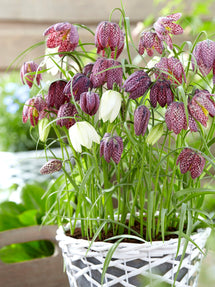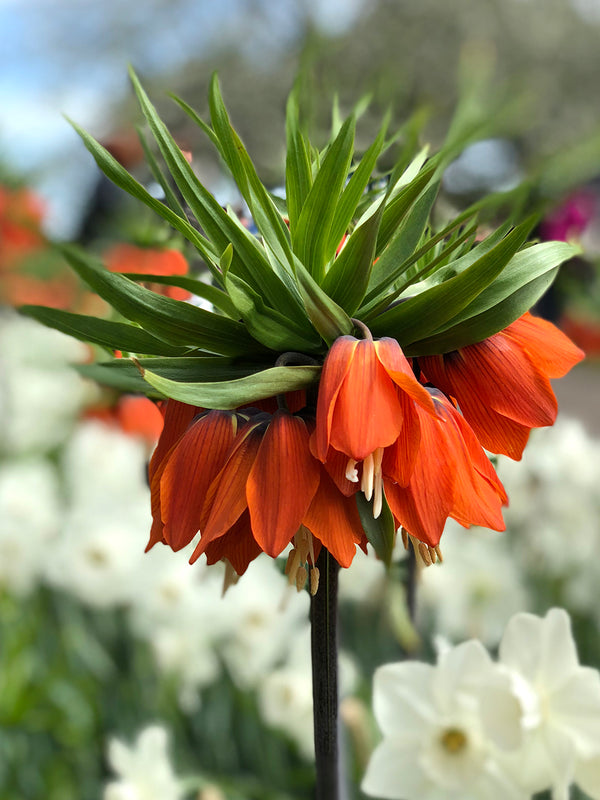Fritillaria
Transform Your Garden With The Exotic Charm Of Fritillaria
Add a touch of exotic elegance to your garden with the beautiful Fritillaria. This delicate flower has been adorning gardens and meadows for decades. With its unique, striking appearance, Fritillaria can transform any garden into a breathtaking display of beauty. From unusual checkered patterns to vibrant shades of yellow, orange or red, these extraordinary beauties come in various styles and colors to suit all tastes.
Discover the charming range of top-quality Fritillary bulbs for sale at DutchGrown and enjoy this beauty for a refreshingly different spring.
Showing 1 - 6 in 6 items
exotic Fritillary bulbs for your garden
Fritillaria: A Delicate And Exotic Flower For Every Garden
Fritillaria belong to the Lily family (Liliaceae) and are commonly known as Fritillaries. The name is derived from the Latin word “fritillus", meaning dice box and refers to the checkered or mottled patterns found on the petals of many Fritillary species.
Fritillaries have been cultivated for centuries. The first recorded cultivation of Fritillaries dates back to the early 16th century, when they were grown in English gardens. With good reason, as these flowering plants are as delicate as they are exotic, with unique shapes and rich colors that evoke a sense of luxury. This versatile family adds a touch of class to any garden design, whether you're looking for an extravagant floral display or a subtle, refined look.
Although some varieties are known for their strong, pungent odor, which is said to serve as a natural deterrent, Fritillaries are beloved by pollinators, including bees and butterflies, for their nectar-rich flowers. These perennials play an important role in supporting pollinators and contributing to the overall biodiversity of ecosystems.
Fritillaria Varieties: From Fritillaria Imperialis To Fritillaria Meleagris
Fritillaria species come in different shapes and sizes, making them a versatile option for different tastes. Below are some fun facts about a few species:
The majestic Fritillaria “Imperialis” (Crown Imperial) is one of the best-selling Fritillaria bulbs. This plant features tall stems crowned with clusters of orange, red, and yellow bell-shaped flowers, and is grown in gardens for its ornamental value. It grows to one to three feet tall and has a long blooming time during early and mid-spring. This beautiful plant will be unlike any other in your garden.
Another popular and impressive variety is the Fritillaria “Meleagris”, sometimes called the "Guinea Hen Flower", "Chess Flower", or “Snake's Head Fritillary”. This unusual-looking flower is an ideal addition to rock gardens, cottage gardens, traditional gardens, or meadows. It is a beloved symbol of conservation efforts to preserve meadow habitats.
How To Grow Fritillaria For A Charming Garden
Fritillaries are known to be challenging to cultivate and require special growing conditions. But with the right care, you will be rewarded with unique flowers in your spring garden. Here's how to make sure your Fritillaria bulbs thrive.
The best time to plant Fritillaria bulbs is in the fall, before the first frost sets in. Select a location with humus-rich, well-drained, and consistently moist soil, ideally in full sun to light shade. Dig a hole in the ground and ensure the bulb has at least two times its height of soil above it in the planting hole. Space smaller bulbs two to five inches apart and larger ones up to twelve inches apart. Cover the bulbs with soil and water well after planting, but avoid overwatering.
Wait patiently for winter to do its magic underground, and spring will surprise you with the rewards of your work. During the flowering season, water only when there has been no rain for three to five days. Need some more help with growing Fritillaria flowers? Follow our guide “How to Grow Fritillaria?”.
Fritillaria bulbs grow best in USDA hardiness zones 4-9. Do you live in zone 9 or higher? The soil won’t get cold enough for root development, but you might consider forcing.
Discover Top-Quality Fritillaria Bulbs For Sale At DutchGrown
We understand that your garden is a reflection of your style and taste. At DutchGrown, we proudly offer top-quality, hand-picked Fritillaria bulbs to help you create the garden of your dreams. Whether you prefer a tall, beautifully coloured variety, such as Fritillaria “Persica”, or want a subtle, low-growing variety, our Fritillaria bulbs will help you create a truly unique garden. Order your Fritillary bulbs for fall planting and experience the unsurpassed quality that only a trusted expert like DutchGrown can provide.
Frequently Asked Questions About Fritillaries
Does Fritillaria Come Back Every Year?
Fritillaria is a perennial flower, which means it will return year after year if planted in the right conditions. With proper care and minimal watering during the flowering season, you can enjoy its stunning blooms season after season.
Does Fritillaria Smell Bad?
Some Fritillaria varieties, not all, have a strong odour that can be quite pungent, especially the Fritillaria Imperialis (Crown Imperial). While this scent may not be pleasant to everyone, it would serve a practical purpose by repelling pests and small mammals, such as mice. Many gardeners use these bulbs as a natural deterrent by placing them in areas such as garages to keep unwanted animals away.
Are Fritillaries Invasive?
Fritillaries are not considered to be invasive. These perennial flowers are well-behaved in the garden and usually do not spread aggressively. However, some species may naturalize and spread if conditions are favourable.
Where Do Fritillaries Grow Best?
Fritillaries grow best in full sun or partial shade. To ensure healthy growth, plant the bulbs in humus-rich, well-drained soil during the fall. Good drainage is crucial, as waterlogged soil can cause the bulbs to rot quickly. During the blooming season, water only every two to five days if there has been no rain.
